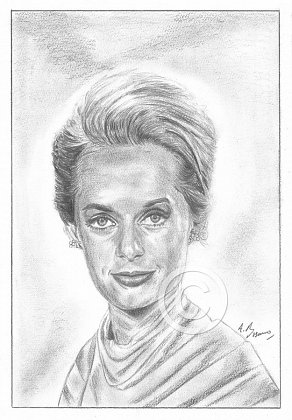‘Tippi’ Hedren
Pencil Portrait by Antonio Bosano.

Shopping Basket
The quality of the prints are at a much higher level compared to the image shown on the left.
Order
A3 Pencil Print-Price £45.00-Purchase
A4 Pencil Print-Price £30.00-Purchase
*Limited edition run of 250 prints only*
All Pencil Prints are printed on the finest Bockingford Somerset Velvet 255 gsm paper.
P&P is not included in the above prices.

Recommended viewing
The Birds (1963)
Marnie (1964)
http://www.antoniobosano.com/film/alfred-hitchcock.php
Roar (1981)
Shadow of a doubt (1991)
http://www.iamnotastalker.com/2016/10/20/the-shadow-of-a-doubt-remake-house/
Surfing
Tippi - A memoir (2016)
Skip the first 100 pages and get to the real meat of Tippi’s memoir, her personal recollections of “Roar,” an eleven year film project that rivals “Le Mans” as both monumental folly and sheer tedium in equal measure. What McQueen managed with racing cars, Tippi would equal with big cats.
On safari with her husband, the couple were taken to a palatial estate formerly owned by a game warden who had abandoned the property many years before. The remaining structure was now home to a large pride of lions. Tippi’s husband became increasingly obsessed with the idea of making a film about their experience and the working title of “Lions, Lions, and More Lions” hinted at a dearth of creative inspiration. The subsequent screenplay with no plot to speak of – other than a house and the lions that live in it – was barely worth the untold list of maulings suffered by the cast and crew alike.


Comments
Last update: 31/12/16
In July 2012, ‘Tippi’ Hedren spoke during a panel discussion on HBO’s upcoming “The Girl,” a television production which recounts her troubled relationship with the director Alfred Hitchcock during the making of “The Birds” and “Marnie”, half a century ago.
“I think he was an extremely sad character,” she said; “We are dealing with a brain here that was an unusual genius, and evil, and deviant, almost to the point of dangerous, because of the effect that he could have on people that were totally unsuspecting”.
I remain uneasy with ‘The Girl’ as a production since it treats every word of Hedren’s story as true, steadfastly siding with the living — who can sue for libel — over the dead, who can’t. That may be fair, but it’s worth noting that we have only Hedren’s word for what happened when she and Hitchcock were alone, and even some of his public behavior is open to interpretation.
Adding, at the HBO event, that she was one of those people directly affected by his genius, the actress conveniently omitted to mention that the director’s alleged behaviour had nonetheless provided her ‘professional raison d’être’ with the world’s press for decades. Without him, would she ever have amounted to that much as an actress, and would we still be interested to this day, in what she has to say?
It’s a moot point and for those loyal to Hitchcock’s memory, here’s the case for the defence.
https://savehitchcock.com/
Nathalie Kay “Tippi” Hedren, a blond beauty from Minnesota, spent her first 4 years in the small town of LaFayette, where her father had a general store that catered to area farmers. The family then moved to Minneapolis — where, at the age of 15, she was spotted by a woman in the modeling industry who asked her to participate in a teen fashion show at a local department store.
The serendipitous encounter launched Hedren on a modeling career that took her all the way to New York City, and a career as a top fashion model with Eileen Ford’s prestigious modeling agency. By the early 1950s, she was earning an “absolutely fabulous” salary.
Hedren was doing so well financially that she was able to afford to travel around the world for six months. She now calls that experience her college education.
Television was the new big thing in the 1950s, and the programming was fueled by commercials. Hedren effortlessly made the transition from posing for still shots, which once put her on the cover of Life magazine, to doing commercials for television.
“One of the commercials I did was for a product called Sego, which was a diet drink made by Pet Milk,” Hedren said. “Apparently, Alfred Hitchcock saw that commercial and decided to find out who the girl was.
“I received a call asking me if I was the girl in the commercial. When I said I was, I was told a producer was interested in me, but they wouldn’t say who. They asked me to come over to Universal [Studios] and we’d talk about it.
“That was on Friday the 13th of October 1961. They ended up putting me through a suspense thriller for the weekend, because nobody would tell me who this producer was.”
The following Monday morning, Hedren returned to Universal to pick up her fashion photo book, which she had left for studio executives to peruse during the weekend. She was then told to go to Music Corporation of America [MCA] which was a large talent agency to meet with other executives.
“The agent at MCA said, ‘Ah, you’re probably going crazy trying to find out who this producer is,’ “ Hedren said. “After I told him I was, he said Alfred Hitchcock wanted to sign me to a contract.
“I just kind of looked at him blankly. He then told me that if I would go over the contract, read it, understand it and sign it we’d go over and meet Mr. Hitchcock. So I was under contract to him before I met him, which I think is unheard of.”
http://www.mirror.co.uk/news/uk-news/tippi-hedren-deeply-regrets-allowing-4462507